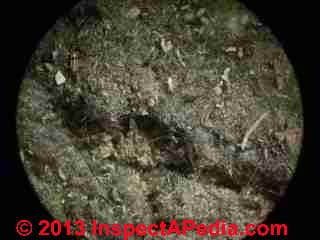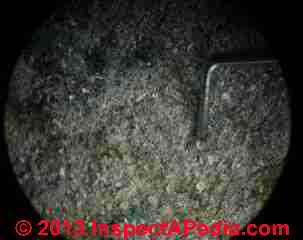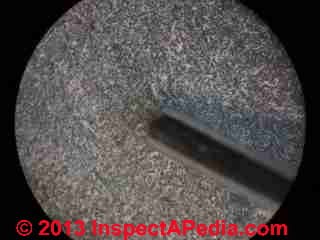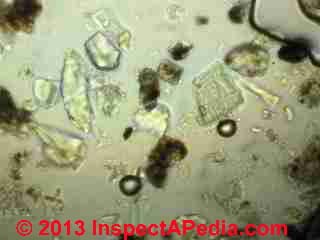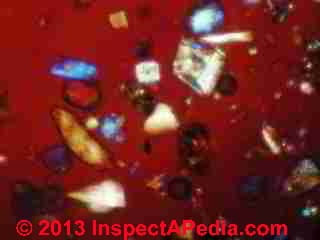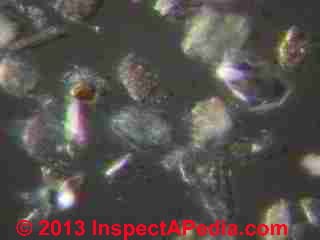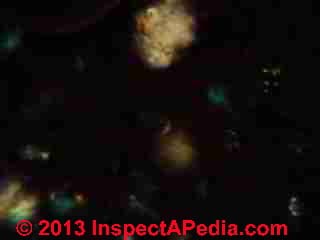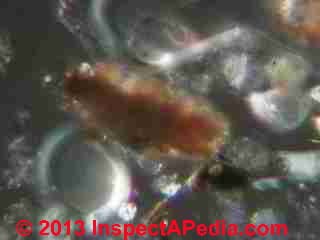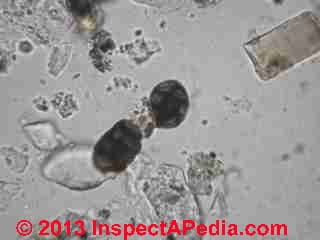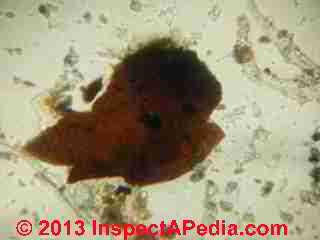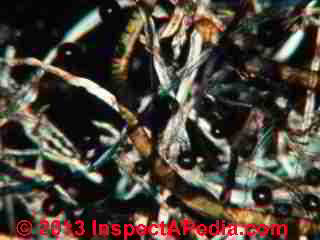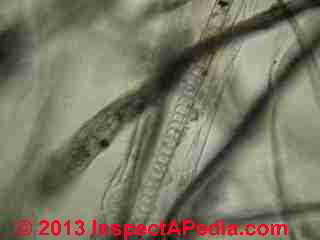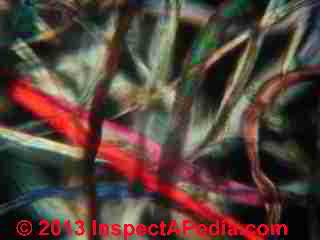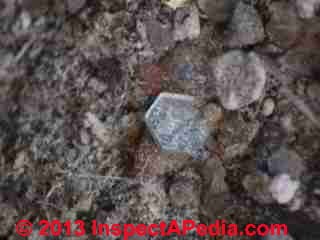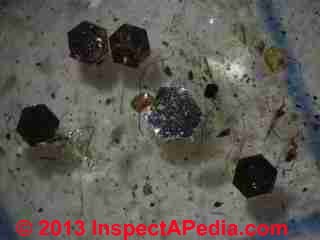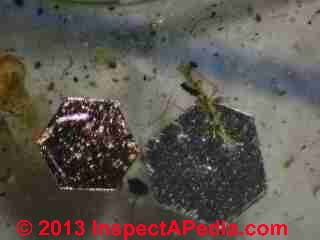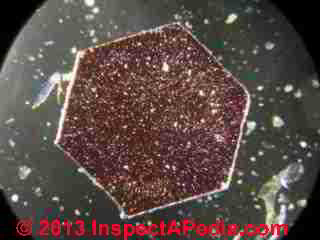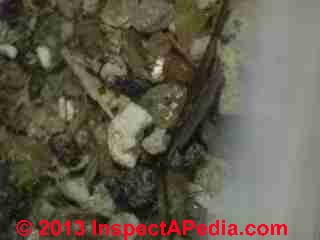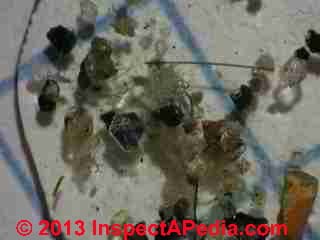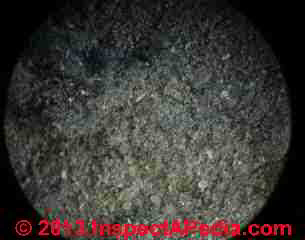 A Photo Tour of the Ingredients in London House Dust
A Photo Tour of the Ingredients in London House Dust
Particle Types, Properties, Questions
- POST a QUESTION or COMMENT about fiberglass dust particle identification procedures & testing
Composition of house dust or building dust:
This article describes and provides microscope photographs of the chief constituents of house dust vacuumed from a single London home. The home is a four bedroom attached home referred to in the U.K. as a council house or in the U.S. as a town house.
Built in 1967 the home includes both carpeted and wood floors. Dust collected by a student using a conventional vacuum cleaner was submitted in two separate bulk samples of 1.75 grams and 2.45 grams respectively.
InspectAPedia tolerates no conflicts of interest. We have no relationship with advertisers, products, or services discussed at this website.
A Microscopic Look at London House Dust
Photos above: macroscopic view of two samples of vacuumed-house dust.
The sample was dominated by fibers and large particles; the right hand photo includes a higher proportion of fine particulates and a dental probe was shown for scale.
Lab photographs included in this article progress in scale of magnification and illustrate different components & features of the dust collected from the subject building.
[CLICK ANY IMAGE to see an enlarged, detailed version.]
In the forensic lab the samples were examined under the stereo microscope for gross characterization, to permit separation of interesting large particles by type (fibers, plaster, paper, other), and to permit preparation of a separate sample of ultra-fine particulates.
Example particles were then examined using transmitted light, reflected light, and polarized light at magnifications up to 1200x. Limited micro chemical testing was also performed as part of particle identification and further analysis is in process.
Gross particle characterization and photomicrographs of dust particles at various magnifications and of various particle types are provided. We do not assert that the particle mix in these samples is "typical" of London homes nor of buildings in general.
I need to know what's in house dust & I want to make something recycled & useful out of house dust
Excerpts of a home dust analysis request from a London student:
For this project, I choose to work around home dust and how we can use dust can be used for an other element or materials can improve our behave in relation with the urban civilisation.
For that i would like to have a maximum of information about dust, what it contains, how much dust we produce in our everyday life.
Photo above: the finest particulates in the samples collected as statically-adhered dust on a petri dish cover. We prepared an adhesive tape sample of these particles for further examination, then proceeded to separate major particle types by size, type and visual properties.
The contents of the ultra-fine particulates shown at left are reported as sample-001 in a table at the end this article. [CLICK ANY IMAGE to see an enlarged, detailed version.]
I have two directions, one will be looking at what is in home dust and try to work around its materiality. Like dead cells, dust mite, textile fibers and several minerals, depending of the history of the area of our house.
The other direction will be looking at how can I design something around [made from] home dust which can be use and be accepted in our environment that can have a impact into our everyday life as something that we reject, which always comes back to us.
I have already been working around different aspects of materiality and observation of home dust powder to maybe construct a design or a material, but ... I was wondering if you know where I can find a list of all the ingredients of home dust might contain within statistics. I tried to find it online but unfortunately I did not find more then dead cells, textile fibers, hair, etc. - Anon 4/21/13 [Edited for privacy, style & grammar - Ed.]
Reply: define your house-dust-contents question
I'll be glad to assist you. First here is a hint when asking a busy professional for help: make your question narrow and specific.
Asking most working experts to "tell me all about ..." is not likely to get much of a response - how can I tell you, in an email, everything I have learned about dust or indoor air quality over forty years of education, field study and lab experiment. It is an inappropriate question. You will perhaps get better response, or more useful one, by posing a more narrow request.
...
House dust contents photos above from sample 001 in the table below, mineral granules in transmitted & partially-crossed polars of polarized light.
As a preliminary step, try searching our inspectApedia.com in the search box found in the blue area near page top - search on "dust" or "house dust" or "carpet dust" or "indoor air quality" or "indoor mold" and you will find hundreds of articles on this topic, from lab procedures, through field procedures, to cleanup or problem prevention. - 22 April 2013
...
House dust contents photos above: mineral granules using reflected light or "top lighting" at 1200x (above left) and in crossed-polars polarized light (above right).
Meanwhile, if you have not read the articles listed below, they may be of interest to you as they give some background in what is in house dust, what health issues are common, both rational and irrational, dust collection methods, laboratory procedures for dust analysis and related matters.
House dust photo at left: insect fecal and mineral granule particles at 1200x, reflected light.
- ACCURACY vs PRECISION of MEASUREMENTS
- DUST, HVAC CONTAMINATION STUDY
- DUST SAMPLING PROCEDURE
- DUST ANALYSIS for FIBERGLASS
- ENVIRONMENTAL TEST ERROR TYPES
- FORENSIC & IAQ LABORATORY SERVICES
- HOUSE DUST COMPONENTS
- MORGELLONS SYNDROME
- MORGELLONS SYNDROME FAQs
Let me know if any of those articles leave you confused or with questions. - Ed.
Reader follow-up: I want to define the quantity of each type of particle in a vacuum cleaner bag to determine the annual particle quantities in buildings. Annual house dust volumes in the U.K.
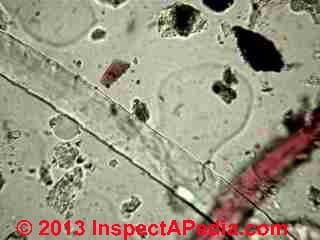
... After a long conversation with one of my tutor, I decided to test my sample house to be able to define the quantities of different particles we can collect in one vacuum cleaner bag, to be able to have an idea of how many things we get per year. That information will give me a better idea of masses that I can use to make a design out of the material.
Vacuumed house dust photo at left: animal hair (hyaline) and synthetic fiber along with road dust & debris.
So for what I have got so far is per year, in UK houses we collect +/- 18.14 kg of home dust per house. It will be nice to know the quantity of dead cells, zinc, textile fibers.
Do you know if your laboratory could do that, and also if it is easy to send you a vacuum bag full of dust to the states or do you know an other Lab could do it in the UK ? - [Anon]
Reply: interesting question, questionable dust analysis approach: counting individual particles contained in an entire vacuum cleaner bag of dust is not practical; representative sampling may be feasible
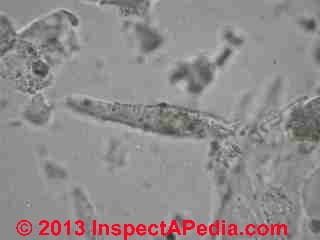
The short answer is yes we would be glad to take a look at your dust sample, in limited quantity, at no fee. But no. Do not send us a vacuum cleaner bag full of dust while asking for an individual particle count or analysis. And don't send such a bag to another lab either. Not just yet. Think about it. Analysis of large bulk samples by weight and by special methods is feasible but not manual particle counting.
House dust photo at left: shape and size (1200x) suggests rodent dander.
Consider the absolute number of individual particles that are collected onto a microscope sampling device or slide for individual particle identification and counting.
A 100% analysis of one slide that may contain less than 1000 individual particles is still going to take anywhere from 20 minutes to more than an hour depending on the slide preparation, particle types that are present, number of unknowns for research.
The number of individual microscopic particles in a vacuum cleaner bag of particles would be in the trillions of trillions.
An assay at a particle level of such a huge quantity is beyond reasonable capacity of any forensic laboratory - which means we would never take that approach. Think about asking a lab to spend about 100 million hours of analysis time at a microscope!
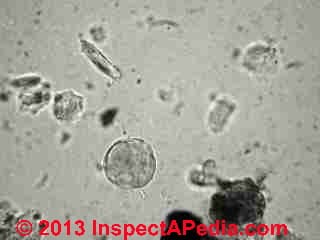
Vacuumed-up house dust photos above: left: pollen and insect fecal below: mold spores, Pithomyces chartarum; both of these are typical particles found at low levels in house dust and have usually been delivered by outdoor air.
Consider further that there may be ultra-small particles down in the sub-micron range that nonetheless in some samples could be important, or harmful. A HEPA-rated filtration level vacuum cleaner bag collects particles down to the 0.3u level. At those small levels even microscopic analysis is incomplete, or perhaps inadequate.
The approach you describe is simply not reasonable in terms of cost nor time for such an assay.
House dust contents photo at left, probable insect fragment;
There ARE dust sampling services that characterize the contents of building dust by weight using other assay methods, but in volumes that are similarly microscopic compared to your suggestion of vacuum cleaner bags full. Rather a tiny collector filter is placed over the end of a vacuum cleaner wand that in turn collects 100% of particles from a small volume or surface - to produce a few grams of material to be assayed.
So what might you do next?
What would be reasonable, and has already been performed countless times, is to design an indoor particle screening or sampling approach looking at settled dust or (in my opinion much less reliable) airborne particulates indoors.
A quick look on Google Scholar will show you that there are several thousand such studies that have been performed, many by experts. Or you can find some of these reference citations in my own published articles on building dust.
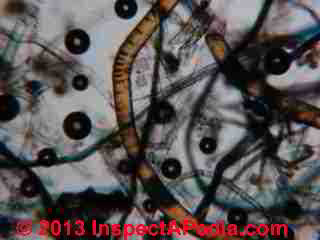
Photos from vacuumed house dust sample, fabric or carpet fibers made up a significant portion of the sample volume.
In the photo above, the round spherical items with light dots in their center are not particles, they're an artifact: air bubbles introduced into the particle sample by the particular combination of choice of a viscous mounting fluid (triacetin) and a sample that was sufficiently dense in particle mass that it trapped air under the cover slip.
Below the fibers are shown in polarized light.
I applaud your interest, energy, and I commend you for thinking "out of the box" of conventional thought, as we say. But let's not embarrass ourselves by forgetting to take a first most basic step in research - to see what has already been studied and to form an opinion about that body of work.
We already know pretty well what is in common house dust; I have described it and it has been described in many published articles.
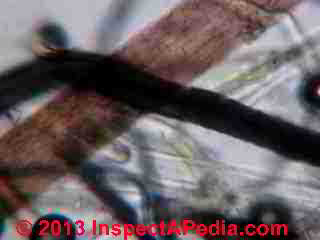
Photo at above left from the vacuumed home dust sample: human hair along with other fibers for scale. Human hair was present but rare in the sample fiber collection. At above right is a probable rodent hair mixed in with other fibers from the same sample.
The contents of dust from a specific building will, of course, vary, possibly significantly from what may have been found in general studies, depending on
Building construction materials, age, location, condition, history of maintenance, leaks Fuels used in the building for cooking, heating, cooling Building contents, furnishings, Building use & occupancy How samples are collected, methodology Where samples are collected throughout a building Variations in building conditions during sample collection
Practical Considerations in "Making a Product out of House Dust"
Before imagining making a product out of dust there are some practical considerations, of which I will list a few here:
Photo at left: beautiful fabric and carpet fibers in polarized light examination of the vacuumed sample of house dust in this London home.
1. Toxicity hazards of materials made from building dust:
While typical house dust is comprised by particles dominated by fabric fibers, skin cells, dust mite fecal pellets, insect fragments, with a usually lower level of pollen and mold spores.
You would need to screen 100% of the material you are planning to use for harmful or toxic or allergenic or pathogenic materials, and you would need to remove or render harmless ALL of these.
Both residential and industrial buildings that in addition to the simple mold and pollen allergens or toxins, yield indoor contaminants that would also require removal. Examples of particles of concern that, depending on the source building, may be included in building or house dust include:

- Allergens: animal dander (e.g. from cats or rodents), insect fragments, insect eggs (photo at left) and insect hairs or other parts; some molds, some fabrics Lead dust from paint in older buildings
- Cadmium & Chromium, other harmful metals besides lead
- Pathogenic bacteria and viruses
- Toxic or pathogenic mold,
- Possible endocrine disruptive chemicals bonded to common plastic or foam products (PCBs for example)
No product could safely be made from building dust without assuring that it does not contain harmful materials; that means a broad spectrum of continuous testing and removal of those materials.
2. Product competitiveness with alternative sources & means
If, for sake of an example discussion, we decided to make felt, perhaps for use as gaskets or hats, our reclaimed building dust based felt has to
- be cleaned of any possibly harmful materials, not just biological ones, but chemicals, metals, &c.
- compete with felt already produced from sources that do not have to contend with these unknowns
I suspect that the cost of the product would exceed any likely sale price.
Even if you decided to isolate and collect building dust to offer it as a fuel for energy production, an activity that is often designed to handle toxins in the incoming waste stream, you'd need to consider the cost-benefit of having taken the trouble to separate and collect vacuum cleaner bags of unknown-content building dust from the ordinary waste stream that goes to those energy producers.
House dust vacuum sample photos above and immediately below: hexagonal reflective crystalline particles of varying sizes; at above right we placed five of these particles on a 1/4" square grid for scale. Below are the same particles at higher magnifications.
Further characterization and source identification are needed.
3. So where do we go from here?
By no means do I want to discourage you from thinking about this topic further, but I am disappointed if your professor or others are not giving you some suggestions on where your energy might be most productive.
Don't feel bad. In my first job I went to my boss with great excitement about a new computer disk access method I had invented. He gently advised me, before submitting the invention for publication throughout the company and world, to just take a look at what other work had been published. To my embarrassment I learned that not only had my "invention" already been invented, but two years before I had actually read the paper describing that work - I had simply forgotten that I'd read it and thought it was my own idea.
Suppose, for example you decided to design an air filter that could detect and warn about harmful levels of common indoor pollutants that were otherwise unknown to the occupants?
You might combine your new dust properties expertise along with with your own or other experts' help in mechanical engineering and heating or air conditioning designers along with increasingly cheaper compute power and microelectronics to design an affordable indoor air filter or filter sensor that worked like a carbon monoxide sensor to keep a running measurement level of a panoply of substances such that if the measurement crosses certain thresholds an alarm is given, along with an indication of what was found and perhaps even where it originated in the building. If such a device were cheap enough to be widely used, that might be exciting.
Building dust photos above: the dominant particles in one of the samples, by volume, were fibers such as those separated and shown at left, and street or road debris, or masonry debris mineral fragments such as those shown at above right.
Some key citations on the contents of house & building dust and that give much of the detail you ask about are found
Reader follow-up:
Thanks so much for your e mail I really appreciate you help and I will ... have a look ... I will ... sample ... my house dust to see what I have got from my own environment and work out from that starting point. - [Anon]
Reply:
We will study a bulk house dust sample as we've been discussing; for any environmental sample we would like to know the time and date of collection Location (type of building, age of building, any interesting building history and observations such as history of flooding or occupant complaints), and location of building as well as from where in the building you think the sample originated.
Keep in mind that it may not be sound practice to assume anything about the homogeneity of a whole vacuum bag of dust unless you know quite accurately where and when the vacuum cleaner was used. - Ed.
Follow-up:
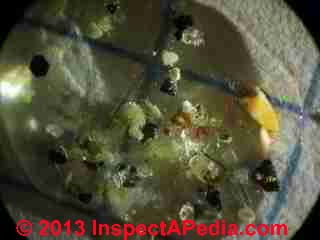
Photos above of the vacuumed house dust in this London home, on a 1/4" grid for scale, illustrate the dominant large & heavy mineral particulates in the sample, along with a fiber fragment and other materials.
The London vacuum-cleaner-collected building dust samples were interesting in two regards: first because of the unusually high proportion of mineral granular debris - such as street or road debris tracked in from an urban environment, or shed by masonry building walls, plaster, &c.
Second there was a lower level of organic material such as skin cells and human or animal hair than I often see; third there are interesting hexagonal crystalline micro particles, perhaps crystals from one of the shedding mineral sources. The table below summarizes what we observed about the two dust samples submitted from this U.K. home.
| Selected Dust Sample Components | Percent of Sample (Estimated) |
Determination of Dominant Particle Types | |
|---|---|---|---|
001 ultra-fine particulates collected by settling & collecting dust from lid of closed petri-dish container of sample. |
<10% of the sample by volume | Significant/dominant spores/particles: Present: mite & other insect fecals (# 078,080), fabric fibers (cotton, synthetic); plaster/drywall dust fragments; Incidental: insect fragments (#094), plant hairs (trichromes) (#068), cobweb fragments (#082), mouse dander (#093), animal fibers (wool)(#086), metallic rust fragments (#089), pollen (#080), fungal spores (Pithomyces chartarum #091), Lab Photos # 060-093 |
|
002 same sample as 001 |
|
||
003 fibers extracted from sample
Combined samples 002-003, fibers, estimate |
60 % of sample by volume | Predominantly cotton & synthetics; incidental animal (wool); Present: human hair; stained or dyed animal hair; Lab Photos # 113-131 |
|
004 coarse particulates extracted from the sample |
30% of sample by volume, and roughly 70% by weight. |
|
Notes to the table above
Sampling location: [Address withheld]; Description: 1967 Council House, 4 bedroom freehold terraced, kitchen, bath, toilette, storage, carpet & wood floors Complaints cited: n/s; vacuum cleaner dust submitted for particle characterization as part of academic study Date Sampled: not stated, presumed November 2013 Date received by lab: 15 Nov 2013 - held for processing Date completed: 12/8/2913
Sample Examination: at 720x-dry & 1200x oil immersion, using transmitted light, polarized light & reflected light; samples were prepared in Acid Fuchsin/Lacto phenol cotton blue/KOH/Lactic Acid/or Triacetin with phenol and other mountants.
The two bulk samples were compared and contrasted:
1 was much higher in fabric fibers and the second higher in fine particulate debris. Under the stereo microscope representative samples of particles & fibers were isolated and examined on individual microscope slides at varying magnifications (Lab photos #001-059).
A tape sample was prepared to collect ultra-fine particulates for separate examination. Two series of photographs, keyed to the table below, are provided: the stereo-microscope and the POLAM microscope up to 1200x.
Limited micro chemical tests were performed such as use of solvents and mountants to aid in particle characterization (Hexane, Na OH, Toluol, Lactic Acid, propanol).
Tape and surface samples: magnifications used for sample examination are listed. Air samples: air volume, magnification, field width, number of traverses, and/or % of trace examined are listed. (Length of trace is standardized to the sampling device used.) When significant-problematic fungal spores are not detected in indoor air samples, quantitative analysis (spore counts) is not performed for air samples unless specifically requested by the client.
“Significant/dominant” means that these particles were present at significant levels in the sample and/or these particles were so frequent that they were the predominant particle found, typically at least 50% of the total particle (or fungal) concentration observed.
Particles listed in this category are likely to be of significance to occupants in the building. Where the particle is a mold genera or species capable of growing indoors a finding at this level makes it likely that there is one (or more) mold reservoir or mold colony in the building.
When the significant/dominant particle(s) present is/are allergenic or toxic mold or an allergen, building investigation to find and clean/remove the problem source is needed.
“Present”means that these are other spores (other than the category just named above) were frequently present in the sample, typically comprising 20% to 50% of the total particle (or fungal) concentration observed.
They are less likely to be of significance to occupants of the building except when particles named are 1. particularly allergenic or toxic 2. are not commonly found in outdoor air or 3. of other technical significance, such as the presence of Pen/Asp spore chains.
The presence of individual or a few spores which may be toxic or allergenic is not normally itself a cause for alarm; however if the building has a history of leaks, water entry, or other hidden moisture problems, the presence of even a few toxic or allergenic spores which are not often found in outdoor air samples may indicate a hidden problem. In these cases further investigation is in order to determine if there is a significant presence elsewhere in the building than from where this sample was taken.
“Incidental” means that I found only occasional, or low-levels of fungal spores in the sample provided, typically less than 20% of the total particle (or fungal) concentration observed, or below the level I usually find in indoor air samples in buildings where there has been a history of leaks, flooding, or known mold contamination. I do not normally report particles in this category except as a point of technical/professional interest.
This is a positive description of the quality of indoor air insofar as fungal spores are concerned, but one cannot unequivocally conclude that there is no possible health hazard present because:
1. individual exposure, sensitivity, and health status vary widely;
2. even a zero count does not mean a particle is not present in the building. It means only that that particle was not in the sample provided. A more careful , expert look at the building may disclose particles that an occupant was unable to recognize and thus did not send to the laboratory for determination.
...
Continue reading at HOUSE DUST COMPONENTS, or select a topic from the closely-related articles below, or see the complete ARTICLE INDEX.
Or see these
Recommended Articles
- DUST SAMPLE TYPES
- TEST KIT for DUST, MOLD, PARTICLES: INSTRUCTIONS
- DUST SAMPLING PROCEDURE where we also discuss finding mold in indoor dust samples
- FIBER & HAIR IDENTIFICATION
Suggested citation for this web page
HOUSE DUST PARTICLE PHOTOS at InspectApedia.com - online encyclopedia of building & environmental inspection, testing, diagnosis, repair, & problem prevention advice.
Or see this
INDEX to RELATED ARTICLES: ARTICLE INDEX to BUILDING ENVIRONMENT
Or use the SEARCH BOX found below to Ask a Question or Search InspectApedia
Or see
INDEX to RELATED ARTICLES: ARTICLE INDEX to BUILDING INDOOR AIR QUALITY IAQ
Or use the SEARCH BOX found below to Ask a Question or Search InspectApedia
Or see
INDEX to RELATED ARTICLES: ARTICLE INDEX to MOLD CONTAMINATION & REMEDIATION
Or use the SEARCH BOX found below to Ask a Question or Search InspectApedia
Ask a Question or Search InspectApedia
Questions & answers or comments about fiberglass dust particle identification procedures & testing.
Try the search box just below, or if you prefer, post a question or comment in the Comments box below and we will respond promptly.
Search the InspectApedia website
Note: appearance of your Comment below may be delayed: if your comment contains an image, photograph, web link, or text that looks to the software as if it might be a web link, your posting will appear after it has been approved by a moderator. Apologies for the delay.
Only one image can be added per comment but you can post as many comments, and therefore images, as you like.
You will not receive a notification when a response to your question has been posted.
Please bookmark this page to make it easy for you to check back for our response.
Our Comment Box is provided by Countable Web Productions countable.ca
Citations & References
In addition to any citations in the article above, a full list is available on request.
- Fiberglass insulation mold: occurrence of mold contamination in fiberglass insulation can be impossible to see with the naked eye, but can be significant
- Horak, B. "Preliminary study on the concentration and species composition of bacteria, fungi and mites in samples of house dust from Silesia (Poland)." Allergologia et immunopathologia 15, no. 3 (1987): 161.
- Fergusson, Jack E., Eric A. Forbes, Robyn J. Schroeder, and Douglas E. Ryan. "The elemental composition and sources of house dust and street dust." Science of the total environment 50 (1986): 217-221.
Abstract: The elemental compositions of house dust, street dust and soil have been determined for 26 elements on material collected in Christchurch, New Zealand. The elements Hf, Th, Sc, Sm, Ce, La, Mn, Na, K, V, Al and Fe may be considered to be soil-based and contribute about 45–50% to house dust and 87% to street dust. The elements which are enriched (>3 times) in the dusts relative to the levels found in local soils, are Br, Cu, Cl, Pb, Zn, Cr, Ca, Co, As and Sb in house dust, and Zn, Cr, Cu and Pb in street dust. - Mølhave, L., T. Schneider, S. K. Kjaergaard, L. Larsen, Svend Norn, and O. Jørgensen. "House dust in seven Danish offices." Atmospheric Environment 34, no. 28 (2000): 4767-4779.
- Butte, Werner, and Birger Heinzow. "Pollutants in house dust as indicators of indoor contamination." Reviews of environmental contamination and toxicology 175 (2002): 1-46.
- Post, S., M. C. Nawijn, T. L. Hackett, M. Baranowska, R. Gras, A. J. M. van Oosterhout, and I. H. Heijink. "The composition of house dust mite is critical for mucosal barrier dysfunction and allergic sensitisation." Thorax 67, no. 6 (2012): 488-495.
- Stapleton, Heather M., Nathan G. Dodder, John H. Offenberg, Michele M. Schantz, and Stephen A. Wise. "Polybrominated diphenyl ethers in house dust and clothes dryer lint." Environmental science & technology 39, no. 4 (2005): 925-931.
- Colt, Joanne S. "Comparison of pesticides and other compounds in carpet dust samples collected from used vacuum cleaner bags and from a high-volume surface sampler." Environmental health perspectives 106, no. 11 (1998): 721.
- Dybendal, T., W. C. Wedberg, and S. Elsayed. "Dust from carpeted and smooth floors: IV. Solid material, proteins and allergens collected in the different filter stages of vacuum cleaners after ten days of use in schools." Allergy 46, no. 6 (1991): 427-435.
- Korpi, A., A-L. Pasanen, P. Pasanen, and P. Kalliokoski. "Microbial growth and metabolism in house dust." International biodeterioration & biodegradation 40, no. 1 (1997): 19-27.
- Lewis, Robert G., Christopher R. Fortune, Robert D. Willis, David E. Camann, and Jeffrey T. Antley. "Distribution of pesticides and polycyclic aromatic hydrocarbons in house dust as a function of particle size." Environmental health perspectives 107, no. 9 (1999): 721.
- Lioy, Paul J., Thomas Wainman, Junfeng Zhang, and Susan Goldsmith. "Typical household vacuum cleaners: the collection efficiency and emissions characteristics for fine particles." Journal of the Air & Waste Management Association 49, no. 2 (1999): 200-206
- Luczynska, Christina M., Yin Li, Martin D. Chapman, and Thomas AE Platts-Mills. "Airborne concentrations and particle size distribution of allergen derived from domestic cats (Felis domesticus)." Am Rev Respir Dis 141, no. 361 (1990): 7.
- Maertens, Rebecca M., Jennifer Bailey, and Paul A. White. "The mutagenic hazards of settled house dust: a review." Mutation Research/Reviews in Mutation Research 567, no. 2 (2004): 401-425.
- Marklund, Anneli, Barbro Andersson, and Peter Haglund. "Screening of organophosphorus compounds and their distribution in various indoor environments." Chemosphere 53, no. 9 (2003): 1137-1146.
- Miller, J. D., A. M. Laflamme, Y. Sobol, P. Lafontaine, and R. Greenhalgh. "Fungi and fungal products in some Canadian houses." International Biodeterioration 24, no. 2 (1988): 103-120.
- Moriwaki, Hiroshi, Yumiko Takata, and Ryuichi Arakawa. "Concentrations of perfluorooctane sulfonate (PFOS) and perfluorooctanoic acid (PFOA) in vacuum cleaner dust collected in Japanese homes." Journal of Environmental Monitoring 5, no. 5 (2003): 753-757.
- Woodfolk, Judith A., Christina M. Luczynska, Frederic de Blay, Martin D. Chapman, and Thomas AE Platts-Mills. "The effect of vacuum cleaners on the concentration and particle size distribution of airborne cat allergen." Journal of allergy and clinical immunology 91, no. 4 (1993): 829-837.
- In addition to citations & references found in this article, see the research citations given at the end of the related articles found at our suggested
CONTINUE READING or RECOMMENDED ARTICLES.
- Carson, Dunlop & Associates Ltd., 120 Carlton Street Suite 407, Toronto ON M5A 4K2. Tel: (416) 964-9415 1-800-268-7070 Email: info@carsondunlop.com. Alan Carson is a past president of ASHI, the American Society of Home Inspectors.
Thanks to Alan Carson and Bob Dunlop, for permission for InspectAPedia to use text excerpts from The HOME REFERENCE BOOK - the Encyclopedia of Homes and to use illustrations from The ILLUSTRATED HOME .
Carson Dunlop Associates provides extensive home inspection education and report writing material. In gratitude we provide links to tsome Carson Dunlop Associates products and services.


